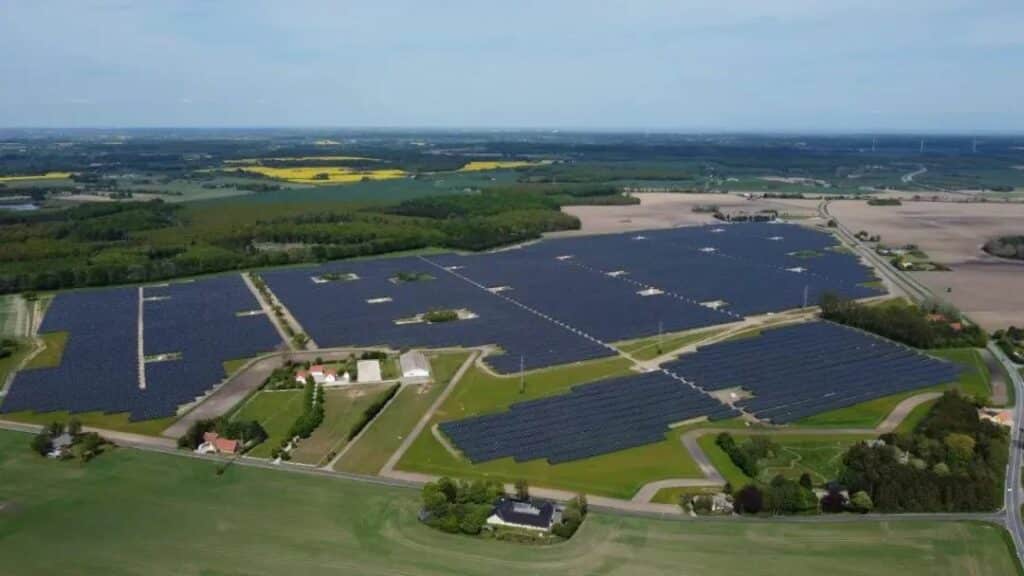CHINT – CHINT’s Denmark PV Project: Europe’s Path to Green Energy
The Danish government has adopted a series of policy measures to promote the development of renewable energy, attracting the attention of companies worldwide.
Several years ago, CHINT Solar had already set its sights on Denmark, an appealing overseas market, and began exploring the construction of several photovoltaic power station projects. Now, they have provided EPC services for Denmark’s Barmosen project.
The Barmosen Solar Photovoltaic Park, located in the city of Vordingborg in the southern part of Zealand Island in Denmark, is a significant solar power project co-constructed by CHINT Solar and European local partners.
The park covers approximately 123 hectares, equivalent to 250 football fields, with a designed power generation capacity of 137.3 MW. The project uses solar panels rated at 540 W, each consisting of two solar cell plates made up of thousands of small solar cell templates.
In accordance with local environmental characteristics, the solar cell plates are arranged from east to west to fully absorb sunlight and ensure a continuous power supply.
According to estimates, once the Barmosen Solar Photovoltaic Park is operational, it will produce about 128 million kilowatt-hours of electricity per year, sufficient to supply green power to 38,000 Danish households.
Simultaneously, the park will reduce carbon dioxide emissions by approximately 106,000 tons each year, significantly reducing the total carbon emissions of the city of Vordingborg.

Data from the Danish Energy Agency shows that as of the end of March this year, Denmark’s installed capacity of photovoltaics has reached 3.2 gigawatts, with an additional 236 megawatts installed in the first quarter.
Solar power has become an important renewable energy source in Denmark, playing a crucial role in the country’s goal of using 100% renewable energy by 2030.
The advantages of CHINT Solar’s new energy development will undoubtedly provide significant support for the green transformation in Denmark and Europe as a whole, jointly promoting global sustainable development.
The project construction manager, Mustafa, expressed his trust and expectation for CHINT Solar: “I believe that CHINT Solar’s advantages in new energy development will further support the green transformation in Denmark and other European countries, jointly achieving sustainable development.”
SourceCHINT Global
EMR Analysis
More information on CHINT: See the full profile on EMR Executive Services
More information on Nan Cunhui (Chairman, CHINT Group): See the full profile on EMR Executive Services
More information on Lily Zhang (Executive President, CHINT Electrics and President, CHINT Global): See the full profile on EMR Executive Services
More information on CHINT Solar: https://www.chintsolar.com/ + Chint Solar is a leading player active in project development, financing, realization and operation of solar parks. We are fully committed to a achieving a successful energy transition in Europe, away from fossil fuels to a sustainable future with clean energy.
Our mission is to energize people. We want investors, landowners and local communities to become part of a future in which green energy is available to everyone. To make that happen, we act now.
Our services cover all aspects of project development from start to finish: from site identification, design and technical planning to financing, construction and operation. In terms of development, landscaping and grid connection, we approach our projects with an innovative mindset as we believe that is the only way to overcome challenges, and create a green and sustainable future.
- 16 completed solar parks in Europe
- 508 MWp
- 1.5 million modules installed
- 240,000 households provided with green energy
More information on Oliver Schweininger (Managing Director, CHINT Solar Europe, CHINT): See the full profile on EMR Executive Services
More information on CHINT Astronergy: https://www.astronergy.com/ + Under the CHINT Group, Astronergy is an intelligent manufacturing enterprise focusing on photovoltaic cells and modules. Founded in 2006, it is one of the earliest private enterprises in China to set foot in the photovoltaic field. Nowadays, its business footprints are all over 140 countries and regions in the world.
Committed to be the most competitive photovoltaic modules supplier worldwide, Astronergy sets its mission to create a sustainable and net-zero carbon world with solar power. Focusing on R&D, production and sales of high-efficiency crystalline silicon PV cells and PV modules, Astronergy has continuously launched the ASTRO and ASTRO N series high-efficiency, high-quality, high-performance modules. Big-size wafer tech enables both bifacial and monofacial ASTRO and ASTRO N series modules could be perfectly applied in all scenarios such as utility-scale power stations, commercial & industrial (C&I) PV systems and residential PV systems. Pioneered the mass production of n-type TOPCon PV modules and Astronergy keeps leads in n-type TOPCon PV cell tech.
More information on Lu Kai (General Manager of Chint Aneng, CHINT Astronergy, President of Zhejiang Zhengtai Anneng Power System Engineering Co., Ltd.): See the full profile on EMR Executive Services
More information on the Danish Energy Agency (DEA): https://ens.dk/ + At the Energy Agency, we work with Denmark’s energy and supply sector. We are a diverse workplace with a focus on interdisciplinary strengths.
At the Danish Energy Agency, we make a difference every day. In Denmark and in countries around the world. Our vision of achieving a climate-neutral society in growth and balance is the biggest task we must help solve. We know that we have to think ambitiously and we know that we have to think new. Our goal is a smart, green transition, where Denmark takes the lead and Danish experience is used globally. Where green solutions, safe and efficient supply and economy are thought together.
The Danish Energy Agency comes under the Ministry of Climate, Energy and Supply.
More information on Kristoffer Bötzauw (Director, the Danish Energy Agency): https://ens.dk/om-os/organisation/kristoffer-bottzauw + https://www.linkedin.com/in/kristoffer-b%C3%B6ttzauw-339a60/
EMR Additional Notes:
- EPC (Engineering, Procurement and Construction):
- An Engineering, Procurement and Construction Contract (“EPC Contract”), occasionally known as a “Turnkey Contract”, is a construction contract where the contractor (“EPC Contractor”) holds the responsibility towards the design, procurement, construction, commissioning and handover of a project (“Project”).
- An EPC contractor performs the engineering, procurement and construction scope(s) for a project, i.e. the EPC executes the actual work.
- Engineering, Procurement, Construction and Installation (EPCI):
- Also referred to as an engineering, procurement, construction and installation contract, this is a contract under which a principal engages a contractor to design, build, deliver and install the asset in order for it to be operational.
- EPCI contracts are often used for large-scale mining infrastructure such as mineral processing plants.
- EPCI contracts are complex because they encompass the design, detailed engineering and construction of infrastructure, including the supply of materials and services (for example, testing and installation) to ensure the smooth operation of the infrastructure.
- Under an EPCI contract, the contractor may perform all the services itself; however, EPCI contracts usually give the contractor a right to subcontract part of the work.
- However, the contractor bears the project risk because most EPCI contracts are for a fixed price (irrespective of subcontractor agreements) and based on a schedule mutually agreed in the EPCI contract. The contract price paid by the principal to the contractor is usually paid in stages on the completion of certain project milestones.
- Carbon Dioxide (CO2):
- Primary greenhouse gas emitted through human activities. Carbon dioxide enters the atmosphere through burning fossil fuels (coal, natural gas, and oil), solid waste, trees and other biological materials, and also as a result of certain chemical reactions (e.g., manufacture of cement). Carbon dioxide is removed from the atmosphere (or “sequestered”) when it is absorbed by plants as part of the biological carbon cycle.
- Decarbonization:
- Reduction of carbon dioxide emissions through the use of low carbon power sources, achieving a lower output of greenhouse gasses into the atmosphere.


